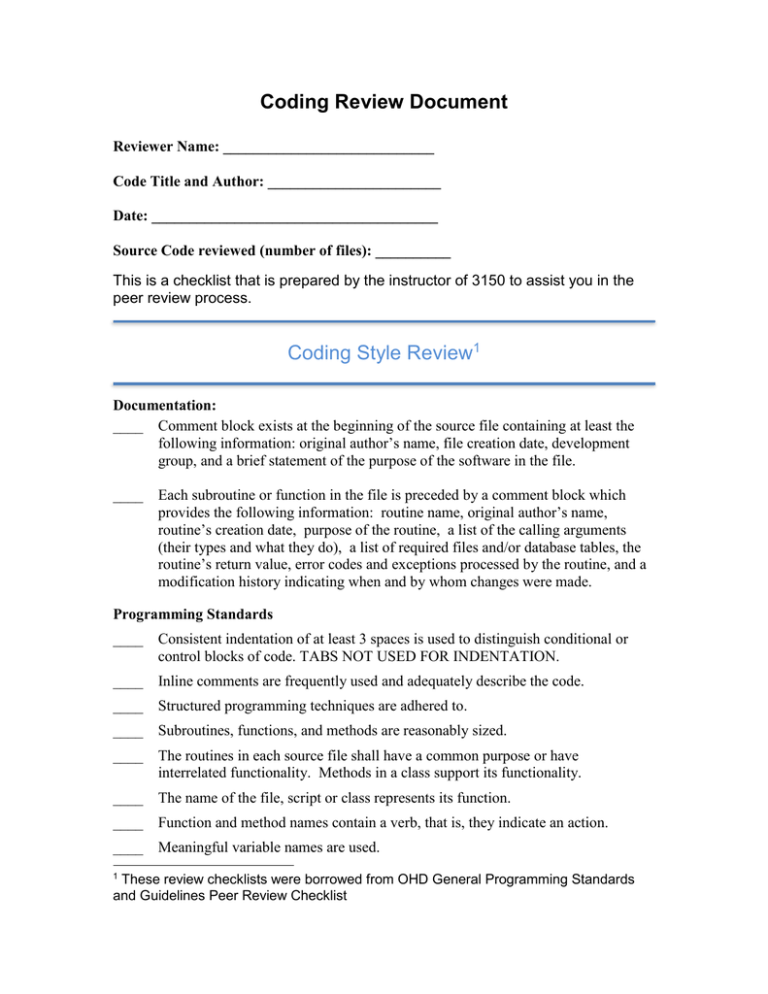Coding Review Document
advertisement

Coding Review Document Reviewer Name: ____________________________ Code Title and Author: _______________________ Date: ______________________________________ Source Code reviewed (number of files): __________ This is a checklist that is prepared by the instructor of 3150 to assist you in the peer review process. Coding Style Review1 Documentation: ____ Comment block exists at the beginning of the source file containing at least the following information: original author’s name, file creation date, development group, and a brief statement of the purpose of the software in the file. ____ Each subroutine or function in the file is preceded by a comment block which provides the following information: routine name, original author’s name, routine’s creation date, purpose of the routine, a list of the calling arguments (their types and what they do), a list of required files and/or database tables, the routine’s return value, error codes and exceptions processed by the routine, and a modification history indicating when and by whom changes were made. Programming Standards ____ Consistent indentation of at least 3 spaces is used to distinguish conditional or control blocks of code. TABS NOT USED FOR INDENTATION. ____ Inline comments are frequently used and adequately describe the code. ____ Structured programming techniques are adhered to. ____ Subroutines, functions, and methods are reasonably sized. ____ The routines in each source file shall have a common purpose or have interrelated functionality. Methods in a class support its functionality. ____ The name of the file, script or class represents its function. ____ Function and method names contain a verb, that is, they indicate an action. ____ 1 Meaningful variable names are used. These review checklists were borrowed from OHD General Programming Standards and Guidelines Peer Review Checklist ____ Variables are initialized prior to use. _____ Braces are used consistently _____ There are no compiler warnings Programming Guidelines ____ Spacing is used correctly to enhance the source code’s readability. ____ When continuing lines of code on new lines, they are broken after a comma or an operator. Higher level breaks are used instead of lower level breaks. ____ Wrapped lines of code are aligned with the beginning of the expression at the same level on the previous line. ____ Program statements are limited to one per line. ____ Nested program statements are avoided. ____ Parentheses are used to remove operator precedence ambiguity and to improve code readability. ____ Inline comments constitute approximately 20% of the total lines of code in the program, excluding the file and routine documentation blocks. ____ The software reflects a balance of coding for efficiency and coding for readability. ____ Meaningful error messages are used. ____ System calls which acquire system resources are tested for error returns. ____ Routines and methods contain no more than 200 executable lines. ____ The number of routines in a source file is kept to a minimum for procedural languages. Any other Comments on style: Coding Design Review2 Performance: Comment on the time required to respond to stimuli (user or internal events). Typical Design/Architectural principles to look for: Connection pooling - reducing the execution time overhead associated with establishing database connections by establishing a shared pool of connections Load balancing – spreading the load evenly between a set of resources Distributed processing Caching – using a local copy of data to reduce access time Lazy instantiation Transaction Concurrency Process isolation between OLTP and OLAP Replication of data Typical unit of measurement you could use: 2 Transactions per unit time Amount of time it takes to complete a transaction These review checklists were borrowed from http://www.codeproject.com/KB/architecture/SWArchitectureReview.aspx Reliability: The ability of the system to keep operating over time in the context of application and system errors and in situations of unexpected or incorrect usage (to perform in a predictable manner). Typical unit of measurement you could use: Mean time to failure Modifiability: The ability to make changes to the system quickly and effectively. Typical Design/Architectural principles: Independence of interface from implementation – This mechanism allows architects to substitute different implementations for the same functionality. Separation – This strategy separates data and function that address different concerns. Since the concerns are separate, we can modify one concern independently of another. Isolating common function is another example of a separation strategy. (High cohesion). Typical unit of measurement: Using specific changes as benchmarks and recording how expensive those changes are to make Functionality: The ability to the system to do the work it is designed to do. Typical unit of measurement: Number change required Extensibility: The ability of the system to handle new feature implementation/replacement of components with improved versions and the removal of unwanted or unnecessary features or components. Typical unit of measurement: Easy, incremental addition of functionality (time, budget, etc.) Coupling/cohesion Maintainability: The ability to quickly identify problems and fixing them within the system quickly Typical unit of measurement: Easy localization Readability of the code Understandability of the code Ripple effects of change Reusability: The ability to use components of the software or system within the system and outside. Additional comments Any other additional comments that the reviewer feels need to be addressed.
